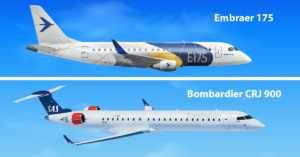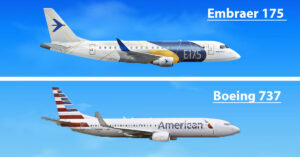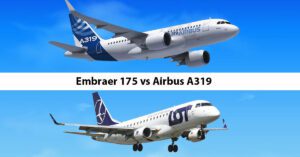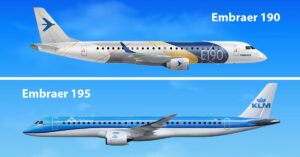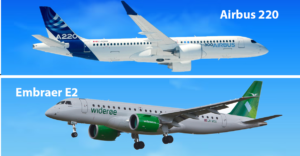Embraer 175 vs 190: Analysis of Regional Jet Efficiency
In the competitive world of regional jets, the Embraer 175 and Embraer 190 have carved out significant niches. Belonging to the same E-Jet family, these aircraft are designed to offer efficiency and comfort but cater to different market segments. This article aims to provide a comprehensive comparison of the Embraer 175 and 190, examining their design, capacity, performance, and operational roles in airline fleets.
Embraer 175 vs 190
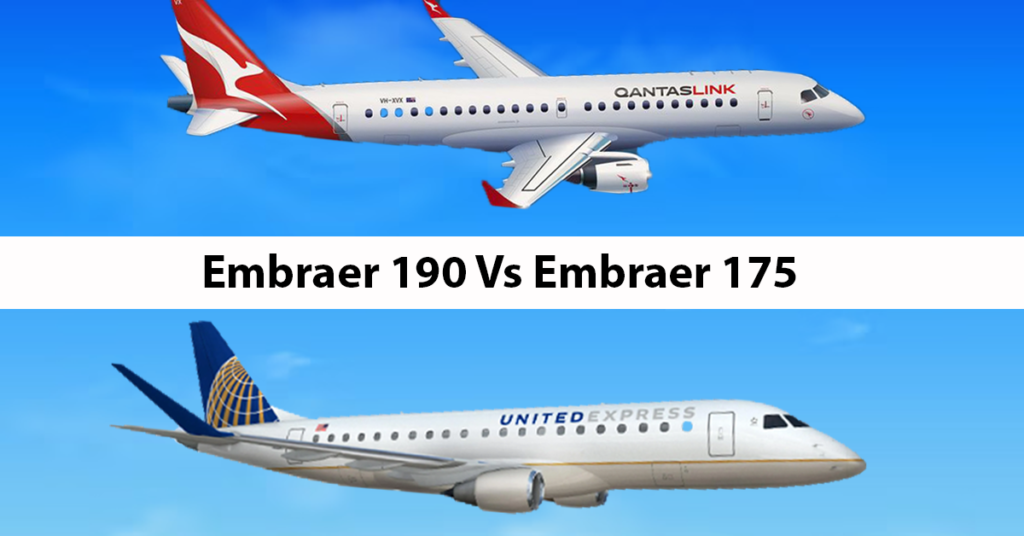
In the comparison of the Embraer 175 vs 190, key differences are evident despite their shared E-Jet lineage. The E175, designed for 76-88 passengers, excels in regional, lower-density routes due to its smaller size and lower operational costs. In contrast, the E190, accommodating 96-114 passengers, is tailored for higher-density routes and longer distances, offering greater capacity and range. While both maintain a 2-2 seating configuration for enhanced passenger comfort, their operational roles and economic impacts differ, catering to distinct segments of the regional jet market.
| Feature | Embraer 175 | Embraer 190 |
|---|---|---|
| Passenger Capacity | 76-88 | 96-114 |
| Range | ~2,200 nautical miles | ~2,800 nautical miles |
| Seating Configuration | 2-2 in economy | 2-2 in economy |
| Operational Costs | Lower | Higher |
| Ideal Use | Regional, lower-density routes | Regional, higher-density routes |
Embraer 175
The Embraer 175, a prominent member of the E-Jet family, is tailored for efficiency in regional aviation. Designed to carry 76-88 passengers, it is perfect for airlines operating on less dense routes. With a range of approximately 2,200 nautical miles, it caters effectively to short to medium-haul flights. The E175 is celebrated for its passenger comfort, offering a 2-2 seating configuration that eliminates the middle seat. Economically viable, with lower operational costs, it is a preferred choice for regional carriers looking to balance efficiency and comfort. Its ability to operate in smaller airports with shorter runways further enhances its versatility in regional networks.
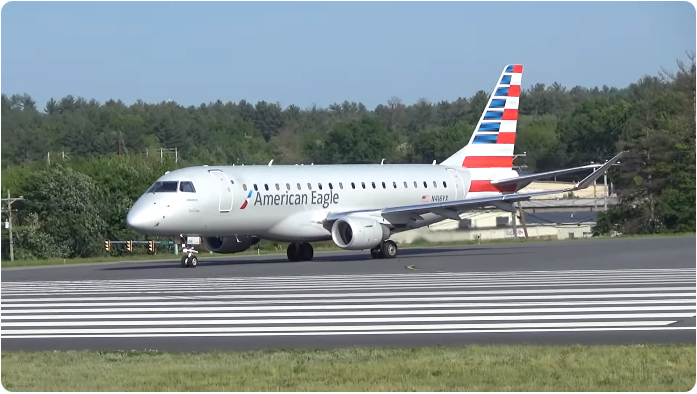
Key Features of the Embraer 175
- Passenger Capacity: 76-88
- Range: Approximately 2,200 nautical miles
- Ideal for regional and lower-density routes
- Lower operational costs
- 2-2 seating configuration in economy class
- Suitable for operations at smaller airports
Embraer 190
The Embraer 190, another key aircraft in the E-Jet series, is designed to meet the needs of higher-density regional routes. Seating 96-114 passengers, it suits routes that demand more capacity than the E175 can offer. With a range of about 2,800 nautical miles, the E190 extends its reach to longer regional and even some transcontinental routes. Like its smaller sibling, it maintains a passenger-friendly 2-2 seating layout. While having slightly higher operational costs, its increased capacity and range make it a profitable option for airlines. The E190’s blend of capacity, range, and comfort makes it an attractive choice for carriers looking to expand their operations across a broader spectrum of routes.
Key Features of the Embraer 190
- Passenger Capacity: 96-114
- Range: Approximately 2,800 nautical miles
- Designed for higher-density routes and longer distances
- Higher operational costs compared to E175
- 2-2 seating configuration in economy class
- Versatility in serving both regional and transcontinental routes
Design and Passenger Comfort
Embraer 175: The Embraer 175 is known for its passenger-focused design. It typically features a 2-2 seating arrangement in economy class, eliminating the middle seat and providing a more comfortable experience for passengers. The aircraft is designed to offer a spacious feel, with large windows and ample overhead bin space.
Embraer 190: The Embraer 190, while maintaining a similar design ethos as the 175, offers a slightly larger cabin. This aircraft also typically features a 2-2 seating configuration in economy, maintaining passenger comfort. The additional cabin length allows for more seat rows, accommodating a larger number of passengers.
Capacity and Range
Embraer 175: The E175 is designed to seat between 76 to 88 passengers, making it ideal for regional airlines operating on less dense routes. It has a range of approximately 2,200 nautical miles, suitable for short to medium-haul flights.
Embraer 190: The E190, with a capacity to seat around 96 to 114 passengers, is suited for slightly longer routes and higher passenger demand. It boasts a range of about 2,800 nautical miles, allowing it to operate efficiently on longer regional and even some transcontinental routes.
Performance and Efficiency
Embraer 175: The E175’s performance is optimized for efficiency on shorter routes. Its size allows for operations at smaller airports with shorter runways, making it a versatile choice for regional and point-to-point services.
Embraer 190: The E190 offers robust performance capabilities, with the ability to serve a mix of short and medium-haul routes. Its larger size and enhanced range make it a popular choice for airlines looking to increase capacity on popular regional routes.
Economic Aspects
Embraer 175: With lower acquisition and operational costs, the E175 is an economically viable option for regional carriers. Its cost-efficiency is particularly valuable for routes with lower passenger volumes or for increasing flight frequencies.
Embraer 190: The E190, due to its larger size and capacity, might have higher operational costs but can lead to higher revenue on routes with greater passenger demand. Its versatility also makes it a good fit for airlines looking to cover a broad range of route profiles with a single aircraft type.
Role in Airline Fleets
Embraer 175: The E175 is widely used by regional carriers and major airlines for their feeder and point-to-point services. Its operational flexibility and lower costs make it a key asset for connecting smaller communities to major hubs.
Embraer 190: The E190 is often utilized by airlines to serve high-density regional routes or as a complementary aircraft on thinner mainline routes. Its larger capacity and range make it suitable for a wider array of operations compared to the E175.
Conclusion
In conclusion, the Embraer 175 Vs 190, though part of the same family, cater to different needs within the regional jet market. The E175 is an ideal choice for airlines focusing on cost-efficiency and flexibility in regional networks, while the E190 offers additional capacity and range, making it suitable for growing routes and higher-density operations. Both aircraft, with their advanced design and efficiency, continue to be integral components in the strategic planning of airlines, aiming to optimize their regional route networks and enhance passenger experience.
FAQs
What is the main difference between the Embraer 175 and 190?
The primary difference is in size and capacity. The E175 seats 76-88 passengers and is suited for shorter, lower-density routes, while the E190 can.
Are the operating costs of the Embraer 175 and 190 significantly different?
Yes, the E175 generally has lower operating costs due to its smaller size, making it more economical for regional and less dense routes. The E190, while having higher operational costs, can generate more revenue on busier routes due to its larger capacity.
Is there a difference in the range of the Embraer 175 and 190?
Yes, the E175 has a range of about 2,200 nautical miles, while the E190 has a slightly longer range of approximately 2,800 nautical miles, making it suitable for longer regional and some transcontinental routes.

